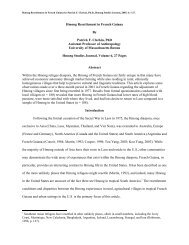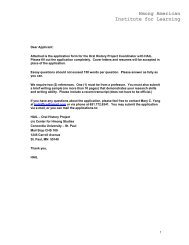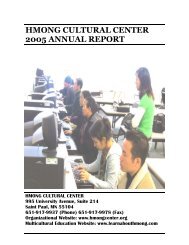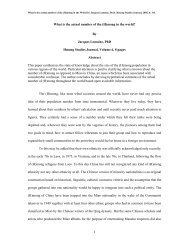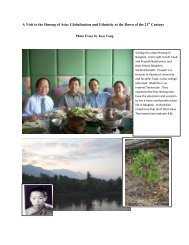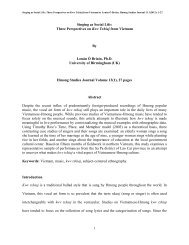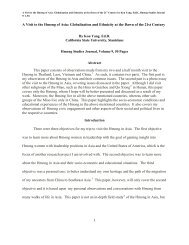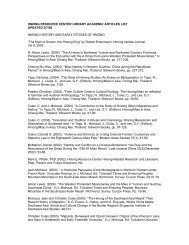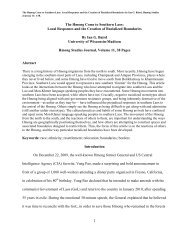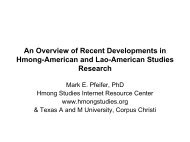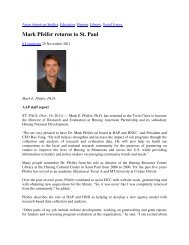Hmong and Lao Refugee Women - Hmong Studies Internet ...
Hmong and Lao Refugee Women - Hmong Studies Internet ...
Hmong and Lao Refugee Women - Hmong Studies Internet ...
Create successful ePaper yourself
Turn your PDF publications into a flip-book with our unique Google optimized e-Paper software.
<strong>Hmong</strong> <strong>and</strong> <strong>Lao</strong> <strong>Refugee</strong> <strong>Women</strong>: Reflections of a <strong>Hmong</strong>-American Woman Anthropologist by Dia Cha, Ph.D. <strong>Hmong</strong> <strong>Studies</strong> Journal,<br />
2005, 6: 1-35.<br />
Description of Chieng Kham <strong>and</strong> Napho <strong>Refugee</strong> Camps<br />
Chieng Kham <strong>Refugee</strong> Camp was opened in 1976 in Phayao Province of northern Thail<strong>and</strong>, <strong>and</strong>,<br />
at that time, occupied twenty-five hectares of l<strong>and</strong>. It was positioned approximately twelve kilometers<br />
from the <strong>Lao</strong>-Thai border, <strong>and</strong>, by the spring of 1992, the UNHCR official figure for the Chieng Kham<br />
camp population was 18,000. Of this population, ninety percent were <strong>Hmong</strong>, about eight percent Mien,<br />
<strong>and</strong> the other two percent Lahu <strong>and</strong> other ethnic groups (UNHCR Chieng Kham <strong>Refugee</strong> Camp Briefing<br />
Paper, 1992).<br />
In 1982, a refugee camp policy was initiated – ironically labeled "humane deterrence" – which<br />
had the unfortunate effect of insuring a greatly attenuated level of camp services. 5 It was hoped that this<br />
policy of humane deterrence would reduce the "magnet effect of drawing additional refugees, as well as<br />
negating the impression that flight automatically leads to resettlement <strong>and</strong>/or improved living st<strong>and</strong>ards."<br />
The policy aimed "to encourage refugees to opt to return to their countries as soon as possible" (CCSDPT<br />
1986:20). Chieng Kham <strong>Refugee</strong> Camp was officially closed in 1995.<br />
Napho Repatriation Center was opened in 1977 on a sprawling site of some eighty-five acres<br />
located in Nakhon Phanom Province, northern Thail<strong>and</strong>, twenty-five kilometers from the <strong>Lao</strong>-Thai<br />
border. The camp was instituted with the m<strong>and</strong>ate that it "provide temporary shelter for <strong>Lao</strong> Lum asylum<br />
seekers until the number of earlier arrivals had been resettled." 6<br />
Since its founding, however, the camp<br />
had gradually exp<strong>and</strong>ed to accommodate an ever-increasing population, <strong>and</strong> the resident population had<br />
5 The humane deterrence policy was "designed to discourage all but the genuinely persecuted <strong>and</strong> truly needy from<br />
seeking asylum in Thail<strong>and</strong>." Under this policy, incoming refugees were detained in camp, where services <strong>and</strong><br />
resettlement opportunities were deliberately kept to a minimum. In 1986, this policy was modified somewhat, <strong>and</strong>,<br />
as refugees moved out of the camp for third country resettlement, refugees from other, closing refugee camps in<br />
Thail<strong>and</strong> were transferred to Chieng Kham camp. Also, new arrivals from <strong>Lao</strong>s to the region were sent to this camp<br />
until about three years prior to commencement of the research herein detailed, i.e., ca. 1989, so that the resettlement<br />
option was still open to qualified refugees of this camp as the research commenced. The Thai government had,<br />
nonetheless, announced that this camp would be closed by the end of 1993, <strong>and</strong>, for this reason, all refugees in the<br />
camp were forced to decide either to resettle in other countries, to repatriate to <strong>Lao</strong>s, or to transfer to Napho camp<br />
(UNHCR Chieng Kham <strong>Refugee</strong> Camp Briefing Paper, 1992; <strong>and</strong> The CCSDPT H<strong>and</strong>book, 1986).<br />
6 In this article, the term "<strong>Lao</strong> Lum" (Lowl<strong>and</strong> <strong>Lao</strong>) is employed to refer to the roughly two million ethnic <strong>Lao</strong> of<br />
<strong>Lao</strong>s. The term "<strong>Lao</strong>" is employed to refer to the overall, multi-ethnic population of <strong>Lao</strong>s, numbering some 4.17<br />
million. (See LAOS, UNDP 1991 Report.)<br />
4




